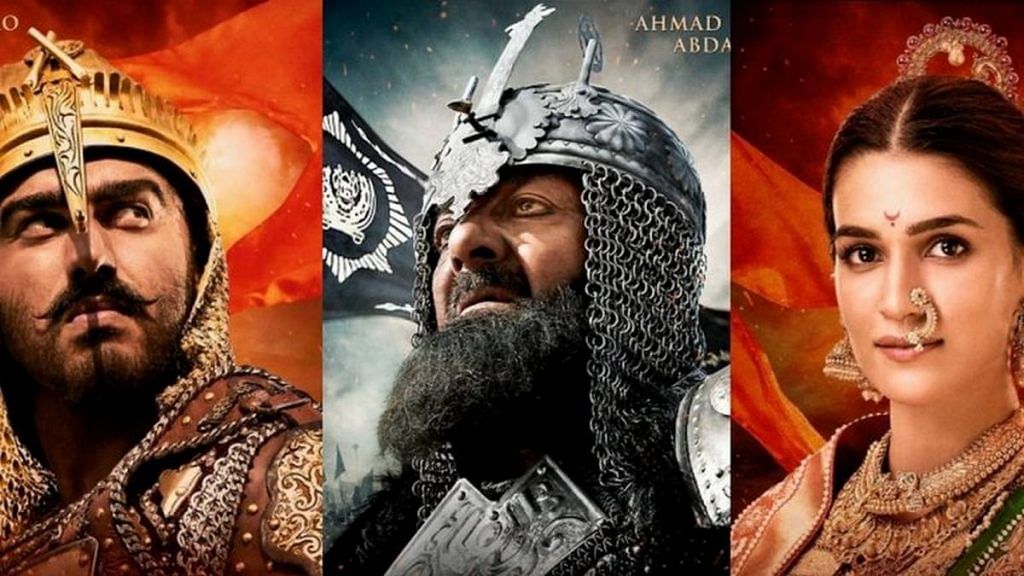New Delhi: Ashutosh Gowarikar’s recently released period drama Panipat has run into a controversy for what critics have called the wrong portrayal of Jat ruler Maharaja Surajmal and Afghan king Ahmad Shah Abdali.
The Jats have alleged that Surajmal has been depicted as being greedy, while Afghans claimed the movie misrepresented Abdali, the founder of the Durrani empire and modern Afghanistan, as a brutal ruler.
The film is the tale of the Third Battle of Panipat fought in 1761 between the Marathas and Abdali. It stars actors Arjun Kapoor, Kriti Sanon and Sanjay Dutt.
Panipat film may have been in the news for all the wrong reasons, but the city — in modern-day Haryana — had played a decisive role in shaping India’s history, not once but thrice.
First battle
It was the first battle of Panipat that established the rule of the Mughals in the Indian subcontinent. Fought in 1526, the Battle of Panipat involved the Mongolian incursion of Hindustan carried out by Zahir-ud-din Babur against the last empire of the Delhi Sultanate — the Lodhi dynasty.
Satish Chandra, in his book Medieval India: From Sultanat to the Mughals Part-II writes, “The battle of Panipat (20 April 1526) was not a sudden development, but was the culmination of the struggle between the two (Ibrahim Lodi and Babur) which had started earlier.”
It was also the first battle where gunpowder firearms and field artillery were used, and it was this artillery, as well as his unique tactics, that helped Babur defeat Lodhi with an army that was grossly outnumbered.
Also read: Panipat was a bloody military debacle for Marathas. Will patriotism-high India see the film?
Second battle
After Babur’s death, the expansionist drive of the Mughals halted. Nevertheless, with the coronation of Akbar as the new emperor, the dream of expanding the frontiers of the Mughal empire resurfaced.
The second battle of Panipat marked Akbar’s victory over his Hindu contemporary — King Hemu, also known as Hemu Vikramaditya and Hemchandra Vikramaditya.
He was previously a general and chief minister of Adil Shah Suri of the Suri dynasty. Hemu gradually moved up the ranks and it is believed that he won as many as 22 wars against the Afghan rebellions of Adil Shah Suri.
Akbar, who was only 13 years old that time, didn’t take part in the battle, and the Mughal army was led by his military commander Bairam Khan.
The third battle
By the mid-18th century, the Marathas had occupied a considerable part of central and northern India by driving out Afghan prince Timor Shah Durrani. However, Delhi continued to remain under the Mughals. Apprehensive of their defeat, the Mughals appealed to Abdali for help.
A fight began between the army of Abdali and Marathas in which Marathas were decimated, with brave warriors Sadashiv Rao and Vishwasrao losing their lives.
The battle and its outcome exposed the disunity and infighting among the Marathas and their allies, making it easier for the European powers to enter Hindustan.
Also read: Panipat review: Almost another lavishly mounted caricature of Muslim invaders as brutes
Panipat and the revision of history
As the controversy surrounding Panipat continues with both the Afghans and Jats fighting to be represented ‘correctly and truthfully’, it is important to raise the question — how much accuracy is there to a truth about a historical event that happened centuries ago?
History is never black and white, perspectives lie in the grey and it is with these perspectives as their backbone that Afghans and Jats have been protesting.
Modern India, with all its boundaries, is not the India that the Marathas, Abdalis or Mughals fought over in the three battles of Panipat.
“The Marathas were in north India to protect their own interests, not to ‘save India’ as it’s now claimed. They were building their own empire and wanted to check the progress of their Afghan rival who also wanted to expand his empire to include north India,” historian Manimughda Sharma tells ThePrint.
The Afghan-Maratha war has been given a religious angle posthumously.
Gowariker’s movie even calls it ‘the great betrayal’ as many Hindu kings supported the Afghans. “There were thousands of Gardi infantry under their leader Ibrahim Khan Gardi who fought for the Marathas while Hindus fought in the Afghan coalition army,” says Sharma, who is also a journalist and an author.
Battles not fought for Panipat
What stands out in all the three battles of Panipat is the fact that the dispute or the reason for war was never the city of Panipat. Panipat was always an entrance to Delhi. Historically, anyone from the North-West, who wanted to capture Delhi, had to come through the Khyber pass and then Punjab.
Sharma elaborated that for anyone looking to establish control over Delhi — Karnal, Thanesar, Kurukshetra and Panipat were the ideal places to stop the enemy from reaching your gates.
“So, you see, several important battles were fought here. Mahmud of Ghazni fought at Thanesar. Shihabuddin Ghori fought Delhi king Prithviraj Chauhan at Tarain near Thanesar twice. The first time Prithviraj and Ghori fought in 1191, Delhi armies didn’t go in pursuit of the Ghurid army beyond Bathinda in Punjab,” Sharma explains.
In order to prevent the aggressors from further expanding their powers in the region, empires in Delhi would invariably end up fighting them at Panipat.
By being the gateway to Delhi and by consequence the key to the peninsular regions, Panipat bore the brunt of battles that were never fought for it in the first place. It just served as an ideal location, with its vast fields, for violence to unfold.
With inputs from Qadeel Qazi.
Also read: Not just Panipat, Kabul unhappy with ‘undesirable’ portrayal of Afghans in other films too
